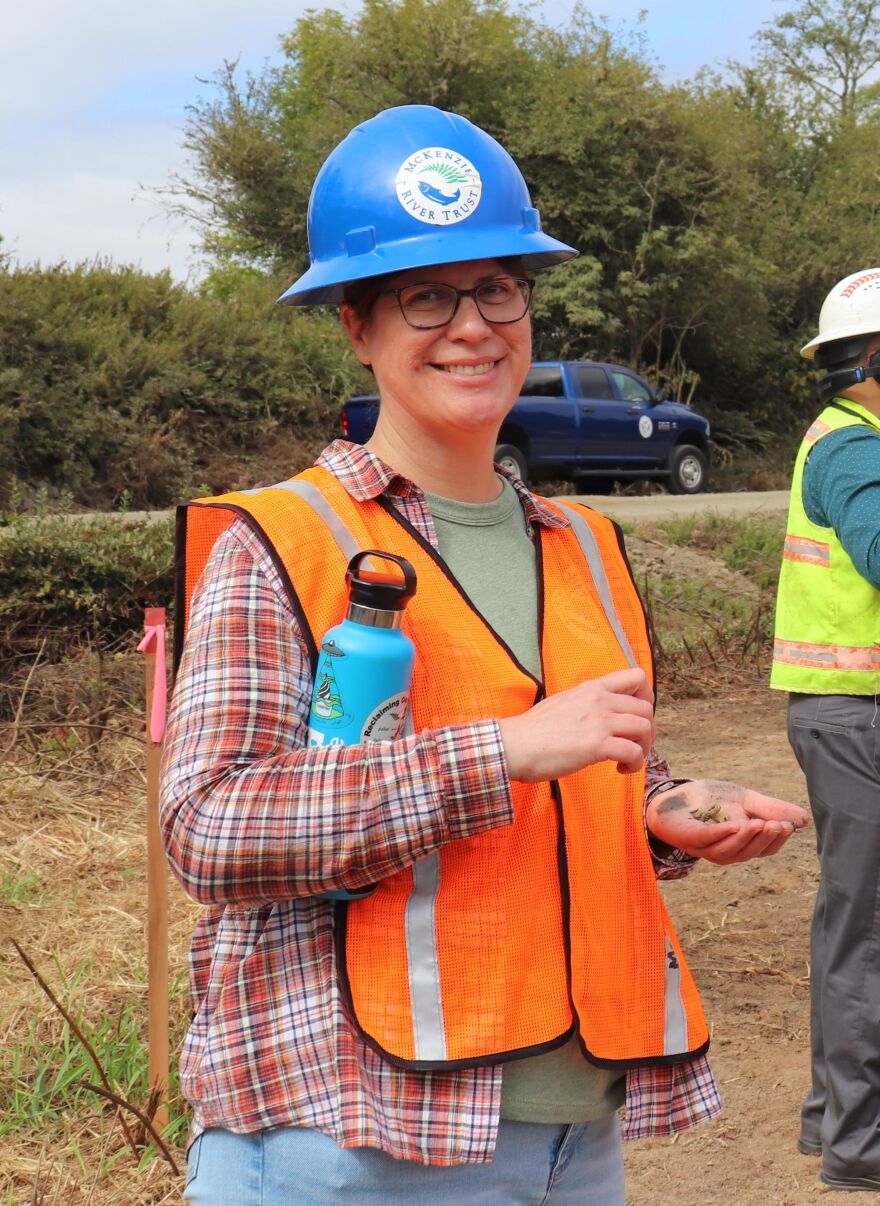Outside Florence, a major restoration project is underway that will reverse over a century’s worth of development and dairy farm operations. Partners behind the Siuslaw Estuary restoration project say it will convert almost 200 acres of land back into an area that will benefit the environment and wildlife, especially salmon.
Recently, on a rugged, rolling landscape of clayish mud and sod, Kyle Terry drove along a section of the Siuslaw Estuary in a small but powerful utility vehicle.
“There were about six linear drainage ditches dug to accommodate the dairy ranch,” he said, pointing to an excavated area. “And we’re going to fill all those in this year, they were originally dug to drain the site so the pasture grass could be raised and cows could graze.”

Terry is the restoration project manager for the Confederated Tribes of the Coos, Lower Umpqua, and Siuslaw Indians (CLUSI.) The estuary area– about three miles east of Florence – was dotted with construction equipment, trucks, and workers.
“So it’s a half a mile long, artificial dike on the perimeter of this pasture that they’ll lower and then actually breach the tidal channel in the middle of,” he said. “It’ll require erosion control measures and turbidity monitoring.”
CLUSI is but one partner behind this effort. Back in 2010, the McKenzie River Trust purchased the defunct dairy farm with the intent to restore it to its original state. Margaret Treadwell, the trust’s Central Coast Conservation Program Manager, told KLCC that working with the tribes and Siuslaw Watershed Council has provided a restoration plan that’ll make a difference.
“You will see the river return -particularly at the high tides- up into this area that we're looking at right now," said Treadwell. "So the river will be coming back in here bringing saltwater, creating just a nice passage for fish to come up through here and spend their, their juvenile time.”
To that end, an excavator dug away at what will eventually become a new primary channel in an area that used to be marshland. Next summer will see the removal of a levee and artificial dike, that’ll allow the Siuslaw River to reconnect with various channels at high tide.

Nearby, Jesse Beers, the cultural stewardship manager for the Coos, Lower Umpqua, and Siuslaw Indians poked around the freshly excavated soil.
“There's cultural resources in the ground so we want to just be mindful of that and make sure we're not disturbing anything,” explained Beers. “There's also a lot of different types of clay in this area that can be used as cultural resources as well for ceremonial purposes and things.”
Beers is mindful that anything -from pottery shards to human remains – can be found in areas important to Native Americans, both past and present.
“Because a big part of restoration for us is not only restoring the lands and waters to functional stasis, but also allowing access to tribal folks to be able to practice cultural activities and use that as a stewardship model as well," said Beers.
Once completed, Beers said there will be a tribal naming ceremony for the restoration area, which will also include a canoe landing. While several names are still being deliberated among a tribal language committee, he said there’s no question this partnership has been an important one for the tribes.
“During the treaty process when our treaty wasn't ratified, our lands were never legally ceded,” said Beers. “So that's part of the reason we see ourselves as such big stewards of our lands and waters. Because we don't really have the population or the capacity anymore to manage those lands as we used to, it's very important for us to work with our partners such as Mackenzie River Trust and Siuslaw Watershed Council holistically to restore these lands and waters.”
The Siuslaw Estuary Restoration project is slated to take two years, at a cost of $10 million. That covers the geotechnical engineering, design, permitting, two construction phases, and revegetation. That’s on top of the purchase of the dairy farm, which was $750,000, funded by a grant from the Oregon Watershed Enhancement Board.
When finished, planners say six miles of habitat will provide feeding and rearing grounds for salmon, steelhead, and lamprey, as well as shorebirds.









